

 |
Search the Site with

|
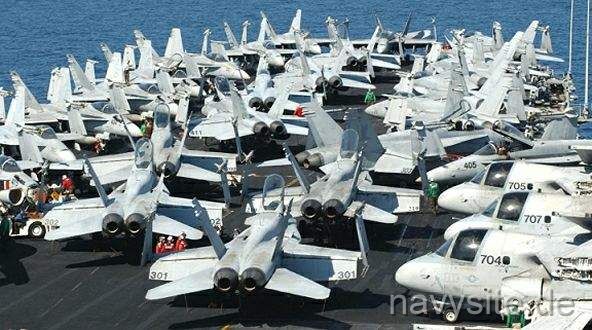 According to Lloyds in London, working on the flight deck of an aircraft carrier is one of the most dangerous jobs in the world. On the flight deck it is loud, crowded and the whole atmosphere is often referred to as 'controlled chaos': Jets are catapulted into the air while others are landing, bombs and missiles are transported from the 'bomb farm' to parking aircraft while other planes are taxiing to the catapults or to their parking locations. Even a little mistake can result in an accident: One can be blown off the deck or be sucked into one of the planes' engines. Dangers are everywhere on the flight deck and that is why the people who are working there have to be in perfect physical and mental condition.
According to Lloyds in London, working on the flight deck of an aircraft carrier is one of the most dangerous jobs in the world. On the flight deck it is loud, crowded and the whole atmosphere is often referred to as 'controlled chaos': Jets are catapulted into the air while others are landing, bombs and missiles are transported from the 'bomb farm' to parking aircraft while other planes are taxiing to the catapults or to their parking locations. Even a little mistake can result in an accident: One can be blown off the deck or be sucked into one of the planes' engines. Dangers are everywhere on the flight deck and that is why the people who are working there have to be in perfect physical and mental condition.
For someone who is not used to this business it is just overwhelming because it is hard to imagine that there is a well thought-out system behind all deck operations. Due to the noise created by jet engines and rotors the communication among the people of the flight deck crew is mostly done through hand signals. These hand signals make up a unique sign language that can basically be seen as the 'language of the flight deck'.
Below, there is a table that contains the most common signals used by the Catapult and Plane Handling Officers.
| Meaning | Command | Video Clip | Photo |
|---|---|---|---|
| Full Power |  | The cat officer shows the pilot that he should activate the plane's afterburner for take-off. Filesize: 40 KByte | 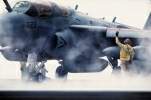 |
| Brake |  | The pilot is shown that he should brake. Filesize: 46 KByte Fists mean "brakes on", open hands mean "brakes off" | 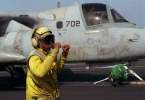 |
| Move Forward |  | no photo available | |
| Go / Launch |  | When this command is shown the plane will be launched. Filesize: 89 KByte | 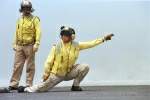 |
| Pull |  | no video clip available | no photo available |
| Lower / Raise Launch Bar | The signal is used to show the pilot that he has to lower his aircraft's launch bar so that the plane can be hooked up in the catapult. Filesize: 45 KByte | no photo available | |
| Slow down |  | no photo available | |
| Stop |  | The plane handling officer wants the pilot to stop his plane. Filesize:49 KByte |  |
| Jet Blast Deflector up |  | The meaning of this signal is that the jet blast deflector behind the plane shall move up so that the following aircraft aren't blown away. Filesize: 48 KByte | no photo available |
| Turn left |  | no video clip available | 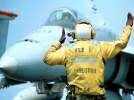 |
| Turn right |  | If the pilot sees this signal he has to turn right. Filesize: 63 KByte | 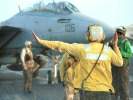 |
| Command is turned over to Catapult Officer to complete the launch sequence | no animation available | This signal is used to show the pilot that the control of the aircraft is turned over from the Plane Director (yellow helmet) to the Catapult Officer (green helmet) no video clip available. | 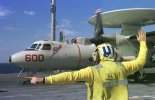 |
| I have control | no animation available | This signal is used to show the pilot that another controller has taken over the control and that the pilot now has to follow the signals of the new controller. no video clip available. | 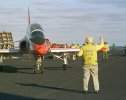 |
| Fold / Spread Wings | no animation available | no video clip available | 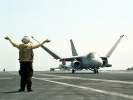 |
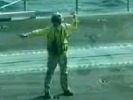 | Click here or the picture on the left to view a short clip of the Catapult Officer's final sequence of handsignals before the plane is catapulted off the deck. Filesize: 382 KByte This is a DivX file. To view it you need a DivX Codec or even better, a DivX player. Both can be found here. | ||
 Back to 1st Page.
Back to 1st Page. Back to selection page.
Back to selection page.